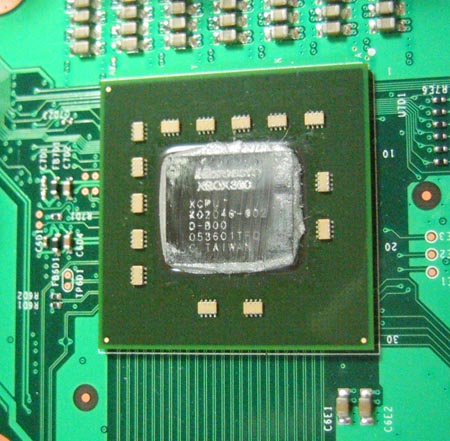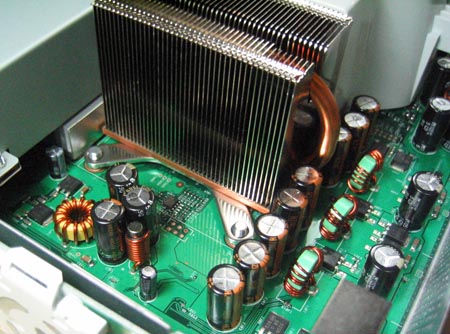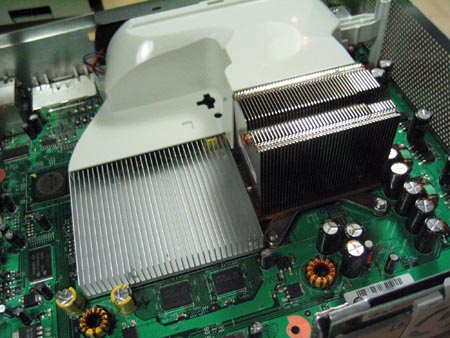Inside Microsoft's Xbox 360
by Anand Lal Shimpi, Kristopher Kubicki & Tuan Nguyen on November 16, 2005 5:09 AM EST- Posted in
- Systems
The Xbox 360 CPU
The original Xbox used a hybrid mobile Pentium III/Celeron processor, but for the 360 Microsoft went to IBM and got the rights to a PowerPC core. The move to the PowerPC instruction set meant that there would be no direct binary compatibility with older Xbox titles, but the sacrifice was obviously deemed necessary by Microsoft.
The CPU itself features three of these PowerPC cores and is currently manufactured on a 90nm process, however Microsoft will most likely be transitioning to 65nm as soon as possible in order to reduce the die size and thus manufacturing costs. Remember that a die shrink from 90nm down to 65nm will cut the size of the CPU in half, and should be possible for Microsoft sometime before the end of next year.
All three cores are identical and feature a 2-issue pipeline and can only execute instructions in-order; we've already discussed the reasoning behind this decision here. The impact of the in-order execution cores is generally a negative one on current game code, but by going with a much simpler core Microsoft was able to stick three of them on a die with hopes of making up for lost performance by enabling some pretty serious multithreading.
Not only does the Xbox 360's CPU feature 3 cores, but each core is capable of executing two threads at the same time, making the CPU capable of simultaneously executing 6 threads. Unfortunately, most titles appear to be only using one or two threads for the majority of their game code, with the remaining threads being used for things like audio encoding/decoding, real-time decompression of game data off of the DVD-ROM and video decoding.
Microsoft has their own license to use and manufacture the CPU used in the Xbox 360, and thus we see their logo on the chip itself. Microsoft cools the 3-core CPU using a fairly beefy heatsink outfitted with heatpipes (pictured below):
Airflow is supplied by the two rear fans in the Xbox 360; the air is channeled over the GPU and CPU heatsinks using a duct. The larger heatsink on the right is atop the CPU, the smaller heatsink is for the GPU:
We have previously discussed the Xbox 360's CPU in much greater detail, which you can read about here.













91 Comments
View All Comments
apriest - Wednesday, November 16, 2005 - link
HD gaming, but no DVI or HDMI?!! Shame, shame Microsoft...Coherence - Wednesday, November 16, 2005 - link
Agreed. I was very surprised to see that DVI/HDMI was left out of the first production run. My HDTV has all its component video inputs used up already, so it would have been nice to plug the 360 into one of the spare HDMI ports. I hate using switchboxes, but that's what I'll have to do with the component inputs now.glennpratt - Wednesday, November 16, 2005 - link
Does you HDTV have VGA? Thier is a VGA out.apriest - Thursday, November 17, 2005 - link
VGA (analog) isn't nearly the quality of DVI (digital), though it would be better than component.JarredWalton - Wednesday, November 16, 2005 - link
My Toshiba HDTV has an HDMI port (no DVI, but a DVI to HDMI cable works). However, it also has two component inputs, and that's far more common than DVI, HDMI, or VGA inputs on HDTVs.cruzer - Wednesday, November 16, 2005 - link
Very slick design, looking forward to getting one!!cruzer - Wednesday, November 16, 2005 - link
On page 5, "two dice on the chip", should that be 'dies' instead of 'dice'?cruzer - Wednesday, November 16, 2005 - link
Nevermind, dice is correct.apriest - Wednesday, November 16, 2005 - link
I was wondering that myself until I looked it up!bldckstark - Wednesday, November 16, 2005 - link
Two dies as in tooling dies, are not referred to as dice. Dies is the correct word. The same applies to computer mouses. The plural for computer mouse is not computer mice, but computer mouses. Mice is a group of more than one animal, not more than one tool. I have thousands of dies here at work, and have worked around millions of dies, never once has anyone even suggested the use of the word dice for them.From dictionary.com -->
die2 pl. dies or dice (ds)
1. pl. dies - A device used for cutting out, forming, or stamping material, especially:
1. An engraved metal piece used for impressing a design onto a softer metal, as in coining money.
2. One of several component pieces that are fitted into a diestock to cut threads on screws or bolts.
3. A part on a machine that punches shaped holes in, cuts, or forms sheet metal, cardboard, or other stock.
4. A metal block containing small conical holes through which plastic, metal, or other ductile material is extruded or drawn.
2. pl. dies Architecture. The dado of a pedestal, especially when cube-shaped.
3. pl. dice
1. A small cube marked on each side with from one to six dots, usually used in pairs in gambling and in various other games.
2. dice (used with a sing. verb) A game of chance using dice.
tr.v. died, die·ing, dies
To cut, form, or stamp with or as if with a die.
I don't care if AT gets it right or not as long as I can understand what they mean, but if we are going to discuss it, let's make sure we are correct.